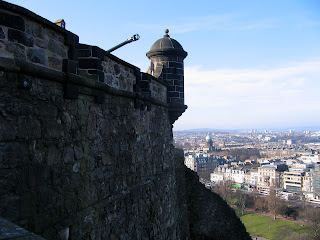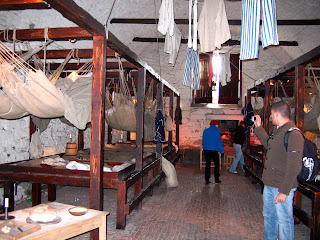Today was the second full day in Edinburgh, and today it was time to see the sights of the high end of the Royal Mile. And again today, the sun was out. First stop was St. Giles Cathedral to snap a few photos, which will come later in this post. Then it was off to the National Museum of Scotland. The museum holds objects that tell the history of Scotland. one interesting item was a ceremonial drinking bowl may have been used by Robert the Bruce. He is represented by the lion in the center. Each of the seven shields around it are symbols of families that were loyal to him.

The museum went up into the 20th century, but this was perhaps the weakest part of the collection. After walking through the museum, it was time to head off to St. Giles Cathedral for church.
Yes, I went to church. While it is known as St. Giles Cathedral, it is not affiliated with the Catholic church (it was for two brief periods in the 17th century), but is part of the Church of Scotland, which is a Presbyterian church. It is tradition for them to hold a short midday service every weekday. And when I say short, I mean short. It was over and done with in less than 10 minutes. Welcome message, prayer, scripture reading, benediction, done. I knew it was going to be short, but I had not expected it to be that short. There were only a handful of people taking part, and the people who did not wish to were asked to remain still and silent at the edges, and to not take pictures. But here are some I took earlier that morning and after the service:


 I then headed down to the downstairs cafe for lunch, and then off to Edinburgh Castle. Instead of going around myself, I waited a short period for a free guided tour. This tour turned out to only be a quick overview of the castle buildings, but it was good to do to get an overall sense of the castle. But before it departed, I got this picture of the "One o'clock Gun", which used to be a time keeping device for the ships in the nearby port, but is still fired six days a week at precisely 1 p.m.
I then headed down to the downstairs cafe for lunch, and then off to Edinburgh Castle. Instead of going around myself, I waited a short period for a free guided tour. This tour turned out to only be a quick overview of the castle buildings, but it was good to do to get an overall sense of the castle. But before it departed, I got this picture of the "One o'clock Gun", which used to be a time keeping device for the ships in the nearby port, but is still fired six days a week at precisely 1 p.m.
The tour helped because then I could pick and chose which areas of the castle I wanted to see. First stop after the tour was the Royal Palace, which is where the "Honours of Scotland" are held. These consist of a scepter, sword, and crown and are considered the crown jewels of Scotland. Before you get to the "Honours", you have to pass through an exhibit on their history which began with this display:
 Then it was on through a few more rooms and you finally arrived in a darkened room with a large glass case containing the "Honours" and the Stone of Destiny, on which all Scottish Kings and Queens are crowned. For hundreds of years it was kept in Westminster Abbey, but was returned to Edinburgh in 1996, but will go back for all future coronations. No photos or video were allowed in the room.
Then it was on through a few more rooms and you finally arrived in a darkened room with a large glass case containing the "Honours" and the Stone of Destiny, on which all Scottish Kings and Queens are crowned. For hundreds of years it was kept in Westminster Abbey, but was returned to Edinburgh in 1996, but will go back for all future coronations. No photos or video were allowed in the room.Then it was off to the Great Hall, which has been renovated many times, but the best feature is the exposed wooden beam ceiling, which contains absolutely no metal. It is held together entirely by wooden pegs.
 After that I headed over to the Scottish National War Memorial, which has to be the most somber building ever. The inside is all dark grey stone and the walls are lined with books listing all the Scottish war dead since World War I.
After that I headed over to the Scottish National War Memorial, which has to be the most somber building ever. The inside is all dark grey stone and the walls are lined with books listing all the Scottish war dead since World War I.
The next stop was the Queen Anne Building, which housed the Prisons of War exhibit. Believe it or not, the vaults of the castle have been used to house prisoners of war during the Napoleonic Wars and, as they called it, the American War of Independence. These vaults held American sailors that were captured off the English coast during the war:

Upon exiting the prisons and on my way to St. Margaret's Chapel, which is the oldest building remaining, I saw that a wedding had just occurred in the chapel. According to the tour guide, this is a common occurrence and the chapel is popular with fathers-of-the-bride since it holds about 20 people. Here are a few photos of the castle and a view of the city from the castle.



After touring the castle I went to two of the small museums on the Royal Mile, The People's story, which tells the story of the ordinary people of Edinburgh, and Museum of Edinburgh, which tells the story of the city's growth. Each of these were so small I was able to both in less than an hour, although I did do them fairly quickly.
Then I headed to the Scotch Whiskey Experience. The best way to describe this place is like Chocolate World at Hersheypark, tasting and all, except with Scotch. They take you on an indoor ride that explains the process of making single malt scotch. Then you learn about the different regions of Scotland that produce Scotch: the Lowlands, Highlands, Speyside, and Islay. We were able top choose which one we tasted, but first they had little bottles that contained a representative smell of the whiskey. I ended up sampling a Lowlands single malt (Glenkinchie 12-year old). At the end they take you into the world's largest collection of Scotch bottles, none of which have been opened. There were nearly 3,400 bottles in the room.

Highlights included a blended whiskey called the Glengoyne Millennium Edition. It contained over 50 different whiskeys, the youngest of which is 30 years old and the combined ages is 2,000 years old. They also had a specially commissioned bottle, of which only just over 100 were ever made (the Queen has #001). I wonder who has #007? They don't know how much it is worth since none of the bottle have ever been put up for sale. They also had this unique bottle, and I think the only thing missing from this picture is some haggis and Robert Burns:

I then returned to my hostel after grabbing dinner at a pub just off the Royal Mile and did a little work before heading to bed. Had to keep up with the "study" part of "study abroad"!

No comments:
Post a Comment